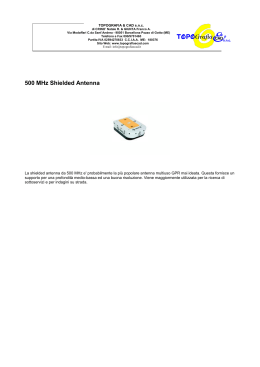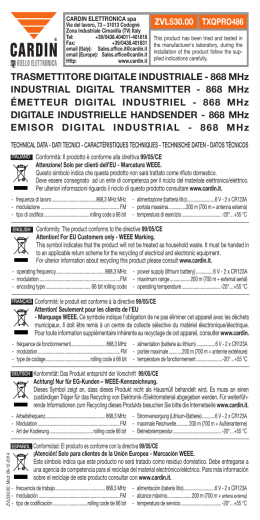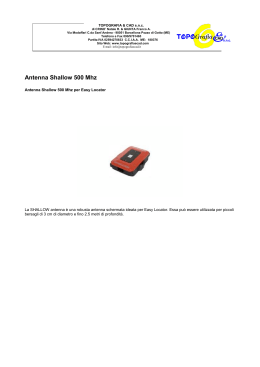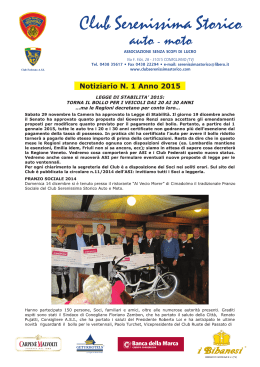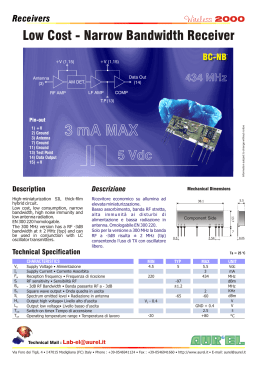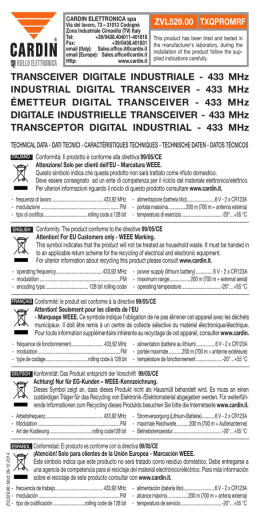CARDIN ELETTRONICA spa Via Raffaello, 36- 31020 San Vendemiano (TV) Italy Tel: +39/0438.404011-401818 Fax: +39/0438.401831 email (Italy): Sales.offi[email protected] email (Europe): Sales.offi[email protected] Http: www.cardin.it CODICE SERIE MODELLO DATA ZVL282.04 S438 FM 21-09-2001 La serie S438 è conforme ai requisiti essenziali fissati dalla direttiva 99/ 05/CE e ad esso sono state applicate le norme tecniche di riferimento. Frequenza: 433,92 MHz per tutti i paesi RADIOCOMANDO DIGITALE A CODICE PROGRAMMABILE S438 Descrizione Il sistema di radiocomando S438 è composto da uno o più trasmettitori e da uno o più ricevitori che saranno combinati in relazione alle esigenze specifiche d'impianto. La codifica con dip-switch a 14 vie, che consente un numero di combinazioni codici utente pari a 16384, ed il particolare protocollo di trasmissione non statico ma ciclico, rendono il sistema semplice nell'installazione e sicuro nell'applicazione. Grazie al tipo di modulazione FM/FSK il sistema offre maggiori prestazioni, in presenza di disturbi e rumore, rispetto ad un sistema tradizionale con modulazione AM/ASK. Possibilità d'impiego Il radiocomando S438 permette l'attuazione a distanza di apparecchiature elettriche ed elettroniche, trovando il suo migliore impiego nel comando di: porte e portoni motorizzati, sistemi d'allarme ed in tutti gli impianti dove sia richiesta l'attuazione a distanza (senza fili), nel rispetto delle norme di sicurezza che regolano l'installazione. Versioni trasmettitori TRQ438200 Trasmettitori tascabili TRQ438400 Trasmettitori tascabili 2 tasti 4 tasti Versioni ricevitori RMS438200 Rx mini con contenitore per uso interno RSS438200 Rx a scheda ad innesto 2 relè 2 relè Ricevitori a scheda (fig. 5) Attenzione! La scheda va adeguatamente isolata dalle parti delle apparecchiature in cui viene incorporata e che si trovano a tensione di rete. • il ricevitore (CS1031) viene inserito direttamente nell'apparecchiatura predisposta a riceverlo con collegamento elettrico: 12V ac-dc con jumper "J1" in posizione "B" 24V ac-dc con jumper "J1" in posizione "A" Il ricevitore a scheda ha due relé le cui uscite sono contrassegnate rispettivamente con CH1 (solo contatto N.A.) e CH2 (contatto N.A.-N.C.). I relé CH1 e CH2 possono essere attivati selezionando, con dei jumper situati sul circuito, le funzioni A, B, C, D corrispondenti alle funzioni CHA, CHB, CHC, CHD del trasmettitori (vedi fig. 3,4). MOD: 02-04-2004 Ricevitori mini IP20 (fig.6) • Il ricevitore (CS1031) è dotato di contenitore da interno e di morsettiera a 8 vie con collegamento elettrico: 12V ac-dc tra i morsetti 7-8. 24V ac-dc tra i morsetti 6-8. Il ricevitore mini ha due relé le cui uscite sono contrassegnate rispettivamente con CH1 (solo contatto N.A.) e CH2 (contatto N.A.-N.C.). I relé CH1 e CH2 possono essere attivati selezionando, con dei jumper situati sul circuito, le funzioni A, B, C, D corrispondenti alle funzioni CHA, CHB, CHC, CHD del trasmettitori (fig. 3,4). Installazione ricevitore-antenna Portata minima e massima dei radiocomandi. Per portata si intende la distanza utile di funzionamento fra trasmettitore e ricevitore con antenna installata, e misurata in spazio libero. La portata è quindi strettamente legata alle caratteristiche tecniche del sistema (potenza e sensibilità) e varia in base alle caratteristiche del luogo di postazione. Per ottenere il funzionamento ottimale del radiocomando è bene scegliere con attenzione i punti d'installazione del ricevitore e dell'antenna. Non è consigliabile l'installazione di due ricevitori che non rispettino una distanza minima di 1,5 m tra loro ed è buona norma posizionare il ricevitore a debita distanza da reti di sistemi computerizzati, da impianti d'allarme e da altre fonti di possibile disturbo. (Sistemazioni anomale potrebbero comprometterne in parte il funzionamento) Antenna L'installazione dell'antenna è fondamentale; collegata al ricevitore rappresenta il punto di ricezione del radiocomando. Nella sua installazione si rispettino le seguenti indicazioni. I ricevitori sono dotati di antenna propria, consistente in uno spezzone di filo rigido, lungo 170mm. In alternativa è possibile collegare l'antenna accordata ANS400 al ricevitore mediante cavetto coassiale RG58 (impedenza 50Ω) di lunghezza max. 15m. L'antenna va posizionata all'esterno nel punto più elevato e visibile, lontano da strutture metalliche. Impostazione del codice e selezione funzioni Il codice deve essere impostato agendo sul dip-switch a 14 vie e deve essere lo stesso sia sul trasmettitore che sul ricevitore. È consigliabile evitare l'impostazione banali cioè tutti gli switch in OFF o in ON. La programmazione può essere effettuata più volte anche successivamente all'installazione, con la conseguente possibilità di garantire la segretezza del codice utente. Trasmettitore Nei trasmettitori ogni tasto corrisponde ad una diversa funzione, con la sola eccezione del trasmettitore a due pulsanti ove al tasto di sinistra è associata la funzione CHA mentre al tasto di destra è possibile associare una diversa funzione agendo sul DIP a due vie (vedi fig. 3,4). CARATTERISTICHE TECNICHE Ricevitore - - frequenza di ricezione ................................................................ 433,92 MHz frequenza dell'oscillatore locale ...................................................... 418 MHz tolleranza dell'oscillatore locale ....................................................... ±75 kHz emissione dell'oscillatore locale.................................................... <-57 dBm frequenza intermedia IF 1.................................................................. 16 MHz frequenza intermedia IF 2....................................................................70 kHz modulazione con ΔF larghezza di banda (sezione RF) .........................................................25 kHz larghezza di banda (bassa frequenza) ................................................10 kHz impedenza di ingresso antenna .............................................................. 50Ω sensibilità (per segnale a buon fine) .....................................................1.5 µV alimentazione ricevitore mini ...................................................12/24V ac-dc alimentazione ricevitore a scheda (selezione tramite J1) .......12/24V ac-dc assorbimento a riposo......................................................................... 28 mA assorbimento con relé attivato............................................................ 55 mA massima potenza commutabile dal relé con carico resistivo: carico in dc .............................................................................................24W carico in ac ............................................................................................60VA tensione massima ......................................................................... 30V ac-dc ritardo all'attivazione del relè .............................................................. 150 ms ritardo alla diseccitazione del relè ...................................................... 150 ms temperatura di esercizio ............................................................-10°…+55°C Trasmettitore - frequenza di trasmissione .......................................................... 433,92 MHz tolleranza sulla frequenza di trasmissione ....................................... ±30 kHz larghezza di banda .......................................................................... > 25 kHz potenza apparente irradiata ............................... -10…-7 dBm (100-200µW) potenza apparente dei prodotti armonici .........................<-54 dBm (<4nW) modulazione ......................................................................................FM/FSK modulazione con ΔF .......................................................................... ≤20 kHz alimentazione (batteria alcalina GP23A) .......................................12V ±10% assorbimento ....................................................................................... 25 mA temperatura di esercizio ............................................................-10°…+55°C umidità relativa..................................................................................... < 95% antenna .............................................................................................Integrata CARDIN ELETTRONICA spa Via Raffaello, 36- 31020 San Vendemiano (TV) Italy Tel: +39/0438.404011-401818 Fax: +39/0438.401831 email (Italy): Sales.offi[email protected] email (Europe): Sales.offi[email protected] Http: www.cardin.it SERIAL NUMBER SERIES MODEL DATE ZVL282.04 S438 FM 21-09-2001 The S438 series conforms to the essential requirements of the directive 99/05/CE and the technical reference standards have been applied. Frequency validity: 433,92 MHz for all Countries DIGITAL RADIO CONTROLS WITH PROGRAMMABLE CODES S438 AT 433 MHz 'FM' Description The S438 radio control system consists of one or more transmitters and one or more receivers which can be combined to meet the specific needs of the system. The code setting method, using a 14-way dip-switch, allows up to 16348 user code combinations and the type of transmission protocol (not static but cyclic) makes the system easy to install and secure. Thanks to the FM/FSK modulation the system gives greater performance when faced with disturbance and noise with respect to a traditional system using AM/ASK modulation. Use The S438 radio control allows the remote activation of electrical and electronic appliances with its best use in the following areas: automatic opening systems, alarm systems, and in all systems which require remote control activation (without wires), in compliance with the safety standards governing the installation of appliances. Transmitter versions TRQ438200 Miniaturised transmitters TRQ438400 Miniaturised transmitters Receiver versions RMS438200 Mini box receiver for indoor use RSS438200 Slot-in receiver card 2 Buttons 4 Buttons 2 Relays 2 Relays Slot-in receiver cards (fig. 5) Warning! The receiver cards must be sufficiently insulated from the parts of the host device which are powered by the mains. • The receiver card (printed circuit CS1031) is inserted directly into an appliance which is designed to receive and has the following electrical connections: 12V ac-dc with jumper "J1" in position "B" 24V ac-dc with jumper "J1" in position "A" The receiver cards are fitted with two relays, the outputs of which are marked CH1 (normally open contact) and CH2 (normally open/normally closed contact). The relays CH1 and CH2 can be activated by selecting the functions A-B-C-D and made to correspond with the transmitter channels CHA-CHB-CHC-CHD by setting the jumpers situated on the circuit board (fig.3,4). Mini receivers IP20 (fig .6) • The mini receiver (printed circuit CS1031) is housed in an indoor container, it is fitted with an 8-way terminal board and has the following electrical connections: 12V ac-dc between binding posts 7-8. 24V ac-dc between binding posts 6-8. The mini receivers are fitted with two relays, the outputs of which are marked CH1 (normally open contact) and CH2 (normally open/normally closed contact). The relays CH1 and CH2 can be activated by selecting the functions A-B-C-D and made to correspond with the transmitter channels CHA-CHB-CHC-CHD by setting the jumpers situated on the circuit board (fig.3,4). Receiver antenna installation Minimum and maximum range of the radio controls. "Range" is intended to mean the working distance, measured in free space, between the receiver and the transmitter with the antenna installed. The range is therefore closely linked to the technical characteristics of the system (power and sensibility) and varies according to the characteristics of the site in which the system is located. It therefore follows that to obtain the best results from the radio control the installation sites for the receiver and the antenna should be carefully chosen. You are not advised to install 2 receivers at a distance of less than 1,5 m from each other and it is also good practise to position the receiver away from computer systems, alarm systems and other possible sources of disturbance. (A bad choice of positioning could compromise the correct performance of the receiver). Antenna The installation of the antenna is fundamental, connected to the receiver it represents the reception point for the radio control. When installing the antenna the following points should be observed. The receiver is supplied with its own antenna which consists of a piece of rigid wire 170 mm in length. In alternative it is possible to connect an ANS400 tuned antenna using a coaxial cable RG58 (impedance 50Ω) with a maximum length of 15m. The antenna should be positioned out of doors in the highest possible point, visible and away from metal structures. Setting the user code and selecting functions The code is set by means of the 14-way dip-switch and must be the same in both the transmitter and the receiver. You are advised to avoid setting obvious combinations such as all the dips in "OFF" or all the dips in "ON". Programming can be carried out after installation whenever required thus allowing you to constantly maintain a secret user code. Transmitters In the transmitters each button corresponds to a different function with the sole exception of the two button transmitter where the left hand button is associated with the function CHA and the right hand button can be associated with a different function by setting the 2-way dip (see fig. 3,4). TECHNICAL SPECIFICATIONS Receiver - reception frequency...........................................................................433,92 MHz - local oscillation frequency .....................................................................418 MHz - local oscillation tolerance ........................................................................ ±75 kHz - local oscillation emission ...................................................................... <-57 dBm - intermediate frequency IF 1......................................................................16 MHz - intermediate frequency IF 2....................................................................... 70 kHz - modulated with ΔF bandwidth (radio frequency section) ......................................................... 25 kHz bandwidth (low frequency) ........................................................................ 10 kHz - antenna impedance in input ...........................................................................50Ω - sensitivity (finely tuned signal) .................................................................... 1.5 µV - mini receiver power supply ............................................................12/24V ac-dc - slot-in card power supply (selected via jumper J1) .......................12/24V ac-dc - maximum power consumption at rest ....................................................... 28 mA - maximum power consumption with activated relay .................................. 55 mA - maximum commutable power at the relay with resistive load: load dc .......................................................................................................... 24W load ac ......................................................................................................... 60VA maximum voltage ................................................................................30V ac-dc - relay activation time...................................................................................150 ms - relay dropout delay ....................................................................................150 ms - operating temperature range ...........................................................-10°…+55°C Transmitters - carrier frequency................................................................................433,92 MHz - carrier frequency tolerance ..................................................................... ±30 kHz - band width ............................................................................................... >25 kHz - apparent radiated power ............................................ -10…-7dBm (100-200µW) - apparent power harmonic products ........................................<-54 dBm (<4nW) - modulation ............................................................................................... FM/FSK - modulated with ΔF.................................................................................... ≤20 kHz - power supply (alkaline battery GP23A) .............................................. 12V ± 10% - maximum power consumption .................................................................. 25 mA - operating temperature range ............................................................ -10…+55°C - relative humidity..........................................................................................< 95% - antenna ................................................................................................. Integrated CARDIN ELETTRONICA spa Via Raffaello, 36- 31020 San Vendemiano (TV) Italy Tel: +39/0438.404011-401818 Fax: +39/0438.401831 email (Italy): Sales.offi[email protected] email (Europe): Sales.offi[email protected] Http: www.cardin.it FASCICULE SERIE MODEL DATA ZVL282.04 S438 FM 21-09-2001 La série S438 répond aux conditions essentielles requises par la directive 99/05/CE et a été réalisée selon les normes techniques de référence. Fréquenza: 433,92 MHz per les pays TÉLÉCOMMANDE DIGITALE ÀVEC CODE PROGRAMMABLE S438 À 433 MHz 'FM' Description Le système de télécommande radio S438 est constitué d'un ou de plusieurs émetteurs et d'un ou de plusieurs récepteurs, qui seront combinés en fonction des exigences spécifiques de l'installation. Le codage par dip-switch à 14 voies permettant un nombre de combinaisons de l'ordre de 16384 et le protocole particulier de la transmission, non statique mais cyclique, rendent ce système simple à installer et sûr lors de l'application. Grâce au type de modulation FM/FSK, le système offre des performances plus hautes que celles d'un système traditionnel à modulation AM/ASK en cas de parasites et de bruits. Possibilités d'emploi La télécommande radio S438 permet de commander à distance des appareils électriques et électroniques et offre un grand éventail d'utilisation dans la commande de fermetures automatisées, systèmes d'alarme et dans toutes les installations qui nécessitent une commande à distance (sans fil) dans le respect des normes de sécurité qui réglementent l'installation. Versions émetteurs TRQ438200 Émetteurs de poche TRQ438400 Émetteurs de poche Versions récepteurs RMS438200 Mini récepteur sous boîtier pour l'intérieur RSS438200 Récepteur à carte 2 touches 4 touches 2 relais 2 relais Récepteur à carte (fig.5) Attention! La carte doit être adéquatement isolée des parties de l’appareil qui la reçoit, en raison du fait que celles-ci sont sous tension. • Le récepteur (CS1031) est embroché directement sur l'appareil prédisposé à le recevoir, avec connexion électrique: 12V ac-dc avec cavalier "J1" en position "B" 24V ac-dc avec cavalier "J1" en position "A" Le récepteur à carte a deux relais, les sorties étant marquées respectivement de CH1 (seulement contact N.O.) et de CH2 (contact N.O. - N.F.). Les relais CH1 et CH2 peuvent être activés en sélectionnant, à travers les cavaliers qui se trouvent sur le circuit, les fonctions A, B, C, D correspondant aux fonctions CHA, CHB, CHC, CHD des émetteurs (fig.3,4). Mini récepteurs IP20 (fig.6) • Le récepteur (CS1031) est doté de boîtier pour l'intérieur et de bornier à 8 voies avec connexion électrique: 12V ac-dc entre les bornes 7-8. 24V ac-dc entre les bornes 6-8. Le mini récepteur a deux relais, les sorties étant marquées respectivement de CH1 (seulement contact N.O.) et de CH2 (contact N.O. - N.F.). Les relais CH1 et CH2 peuvent être activés en sélectionnant, à travers les cavaliers qui se trouvent sur le circuit, les fonctions A, B, C, D correspondant aux fonctions CHA, CHB, CHC, CHD des émetteurs (fig. 3,4). Installation récepteur-antenne Portée minimum et maximum des télécommandes radio: Par portée, nous entendons la distance nécessaire au fonctionnement, entre émetteur et récepteur avec antenne installée et mesurée en espace libre. La portée est donc strictement liée aux caractéristiques techniques du système (puissance et sensibilité) et varie en fonction des caractéristiques du lieu d'emplacement. Pour obtenir un fonctionnement optimal de la télécommande radio, il est important de choisir soigneusement les endroits pour l'installation du récepteur et de l'antenne. En cas d'installation de deux récepteurs, respecter impérativement une distance minimale de 1,5 m entre les deux. Il est conseillé de positionner le récepteur à une juste distance des réseaux avec système à ordinateurs, d'installations d'alarme ou autres qui pourraient provoquer des perturbations. (Des positionnements inadéquats pourraient compromettre en partie le fonctionnement). Antenne L'installation de l'antenne est fondamentale; une fois branchée au récepteur, elle représente le point de réception de la télécommande radio. Pour son installation, observer les indications suivantes. Le récepteur est équipé d'une propre antenne qui consiste en un morceau de fil rigide d'une longueur de 170mm. En alternative, il est possible de brancher l'antenne accordée ANS400 au moyen d'un câble coaxial RG58 (impédance 50Ω) d'une longueur maxi. de 15m. L'antenne doit être positionnée à l'extérieur, sur le point le plus élevé et visible, loin de toute structure métallique. Programmation du code et sélection des fonctions Le code doit être programmé par l'intermédiaire du dip-switch à 14 voies. Il est indispensable que le code de l'émetteur corresponde à celui du récepteur. Il est conseillé de ne pas faire de programmations banales, c'est-à-dire tous les interrupteurs sur OFF ou sur ON. Pour garantir le secret du code usager, la programmation peut être faite plusieurs fois même après l'installation. Emetteur Dans les émetteurs, chaque touche correspond à une fonction différente, à l’exception de l’émetteur à deux touches où la touche de gauche est associée à la fonction CHA, tandis que la touche de droite peut être affectée à une fonction différente en intervenant sur le DIP à deux voies (voir fig. 3,4). CARACTÉRISTIQUES TECHNIQUES Récepteur - fréquence de réception ....................................................................... 433,92 MHz - fréquence de l'oscillateur local ................................................................ 418 MHz - tolérance de l'oscillateur local .................................................................. ±75 kHz - émission de l'oscillateur local ................................................................ <-57 dBm - fréquence intermédiaire IF 1 ...................................................................... 16 MHz - fréquence intermédiaire IF 2 ........................................................................70 kHz - modulation avec ΔF largeur de la bande (section RF) ..................................................................25 kHz largeur de la bande (basse fréquence) ........................................................10 kHz - impédance d'entrée antenne ........................................................................... 50Ω - sensibilité (signal de bonne réussite) ............................................................1.5 µV - alimentation mini récepteur .............................................................12/24V ac-dc - alimentation récepteur a carte (sélection à travers J1) ...................12/24V ac-dc - absorption au repos ..................................................................................... 28 mA - absorption avec relais activé ....................................................................... 55 mA - puissance maximum commutable relais avec charge résistive: charge en dc ....................................................................................................24W charge en ac ...................................................................................................60VA tension maximum .................................................................................. 30V ac-dc - retard à l'excitation ......................................................................................150 ms - retard à la désexcitation ..............................................................................150 ms - température de fonctionnement ........................................................-10°…+55°C Émetteurs - fréquence porteuse ............................................................................. 433,92 MHz - tolérance de la fréquence porteuse .......................................................... ±30 kHz - largeur de bande ....................................................................................... >25 kHz - puissance apparente irradiée ...................................... -10…-7dBm (100-200µW) - puissance apparente des produits harmoniques......................<-54 dBm (<4nW) - modulation..................................................................................................FM/FSK - modulation avec ΔF ...................................................................................≤20 kHz - alimentation (batterie alcaline GP23A)..................................................12V ± 10% - absorption .................................................................................................... 25 mA - température de fonctionnement ........................................................-10°…+55°C - humidité relative ........................................................................................... < 95% - antenne .........................................................................................................intégré CARDIN ELETTRONICA spa Via Raffaello, 36- 31020 San Vendemiano (TV) Italy Tel: +39/0438.404011-401818 Fax: +39/0438.401831 email (Italy): Sales.offi[email protected] email (Europe): Sales.offi[email protected] Http: www.cardin.it ART.-NR. SERIE MODELL DATUM ZVL282.04 S438 FM 21-09-2001 Die Serie S438 entspricht den von der Bestimmung 99/05/CE festgelegten grundsätzlichen Anforderungen und bei ihr wurden die technischen Bezugsnormen angewandt. Frequenzbereich: 433.92 für alle Länder der DIGITALE FUNKSTEUERUNG MIT PROGRAMMIEREN CODENUMMERN 433 MHz 'FM' Beschreibung Das Funksteuerungssystem S438 besteht aus einem oder mehreren Sendern und aus einem oder mehreren Empfängern, die gemäß den spezifischen Anforderungen der Anlage kombiniert werden. Die Kodifizierung mit dem 14-Wege-Dip-Switch, welcher 16384 Anwendercodekombinationsmöglichkeiten bietet, und das besondere, nicht statische sondern zyklische Übertragungsprotokoll gestalten die Installation des Systems einfach und machen dessen Anwendung sicher. Dank des Modulationstyps FM/FSK bietet das System bei Störungen und Rauschen im Vergleich zu einem herkömmlichen System mit der Modulation AM/ASK eine bessere Leistung. Anwendungsmöglichkeiten Die Funksteuerung S438 ermöglicht die Fernbedienung elektrischer und elektronischer Geräte und findet beste Anwendung bei der Steuerung automatischer Öffnungssysteme, Alarmsystemen und bei allen Anlagen, bei denen die Inbetriebsetzung durch Fernbedienung (ohne Drähte) verlangt wird. Sie ist durch einen hochzuverlässigen Geheimcode unter Beachtung der für die Installation geltenden Sicherheitsnormen geschützt. Sender-Versionen TRQ438200 Handsender TRQ438400 Handsender 2 Tasten 4 Tasten Empfänger-Versionen RMS438200 Miniempfänger RSS438200 Steckempfänger 2 Relais 2 Relais Steckempfänger (Abb. 5) Achtung! Die Karte muss in angemessener Weise gegenüber den Teilen der Apparatur, in die sie eingebaut wird und die sich unter Netzspannung befinden, isoliert werden. • Der Steckempfänger (CS1031) wird direkt in die Apparatur eingesetzt, die zu dessen Aufnahme komplett mit dem elektrischen Anschluss vorbereitet ist: 12V ac-dc mit Jumper "J1" in Position "B". 24V ac-dc mit Jumper "J1" in Position "A". Die Empfängerkarte verfügt über zwei Relais, deren Ausgänge entsprechend mit CH1 (nur Einschaltglied-Kontakte) und CH2 (Einschaltglied-/Ausschaltglied-Kontakte) gekennzeichnet sind. Die Relais CH1 und CH2 können durch Wahl der Funktionen A, B, C, D, welche den Funktionen CHA, CHB, CHC, CHD der Sender entsprechen, mittels der auf dem Schaltkreis befindlichen Jumper aktiviert werden (Abb. 3,4). Miniempfänger IP20 (Abb. 6) • Der Empfänger (CS1031) ist mit einem Gehäuse zur Innenanwendung und mit einer 8-Wege-Klemmleiste mit elektrischem Anschluss ausgestattet: 12V ac-dc zwischen den Klemmen 7-8 24V ac-dc zwischen den Klemmen 6-8. Der Miniempfänger verfügt über zwei Relais, deren Ausgänge entsprechend mit CH1 (nur Einschaltglied-Kontakte) und CH2 (Einschaltglied-/Ausschaltglied-Kontakte) gekennzeichnet sind. Die Relais CH1 und CH2 können durch Wahl der Funktionen A, B, C, D, welche den Funktionen CHA, CHB, CHC, CHD der Sender entsprechen, mittels der auf dem Schaltkreis befindlichen Jumper aktiviert werden (Abb. 3,4). Installation Empfänger - Antenne Mindest- und Höchstreichweite der Funksteuerungen: Unter Reichweite versteht sich der nutzbare Betriebsabstand zwischen Sender und Empfänger, deren Antenne im freien Raum installiert und gemessen wurde. Daher steht die Reichweite in unmittelbarem Zusammenhang mit den technischen Eigenschaften des Systems (Leistung und Ansprechempfindlichkeit) und verändert sich entsprechend dem Aufstellungsort. Um einen optimalen Betrieb der Funksteuerung zu gewährleisten, sind die Installationsorte für den Empfänger und die Antenne sorgfältig auszuwählen. Die Installation von zwei Empfängern, zwischen denen kein Mindestabstand von 1,5 m eingehalten wird, ist nicht möglich. Es ist ratsam, den Empfänger in gebührendem Abstand zu Computersystemen, Alarmanlagen und anderen möglichen Störungsquellen aufzustellen. (Eine unsachgemäße Aufstellung könnte den Betrieb teilweise gefährden). Antenne Die Installation der Antenne ist von äußerster Wichtigkeit; nachdem sie mit dem Empfänger verbunden ist, stellt sie den Empfangspunkt für die Funksteuerung dar. Bei ihrer Installation ist folgendes zu beachten. Die Empfängerkarte ist mit einer eigenen Antenne ANS400 ausgestattet, die aus einem Stück Draht besteht, der 170mm lang ist. Alternativ kann eine passende Antenne verwendet werden, die mittels einem Koaxialkabel RG58 (Impedanz 50Ω) mit einer maximalen Länge von 15m an den Empfänger angeschlossen wird. Die Antenne wird im Freien am höchsten und sichtbarsten Punkt von Metallstrukturen entfernt, positioniert. Einstellung des Codes und Funktionenwahl Der Code muss mittels des 14-Wege-Dip-Switch eingestellt werden und sollte sowohl auf dem Sender wie auch auf dem Empfänger identisch sein. Es ist ratsam banale Einstellungen, wie z.B. alle Switch in OFF-oder ON-Stellung, zu vermeiden. Die Programmierung kann zur Gewährleistung der Geheimhaltung des Anwendercodes mehrmals auch nach erfolgter Installation ausgeführt werden. Handsender Bei den Sendern entspricht jede Taste einer anderen Funktion, einzigste Ausnahme der Sender mit zwei Tasten, bei dem der linken Taste die CHA-Funktion zugeordnet wurde, während der rechten Taste eine andere Funktion mittels des 2-Wege-DIP zugeordnet werden kann (siehe Abb. 3,4). TECHNISCHE DATEN EMPFÄNGER - Empfangsfrequenz .............................................................................433,92 MHz - Örtlichen Frequenz .................................................................................418 MHz - Abweichung von der örtlichen Frequenz ............................................... ±75 MHz - Emission der örtlichen Frequenz ..........................................................<-57 dBm - Zwischenfrequenz IF 1..............................................................................16 MHz - Zwischenfrequenz IF 2...............................................................................70 kHz - Modulation mit ΔF - Bandbreite (Bereich RF) .............................................................................25 kHz - Bandbreite (Niederfrequenz) ......................................................................10 kHz - Eingangsimpedanz Antenne .......................................................................... 50Ω - Ansprechempfindlichkeit (eines erfolgreichen Signals) ..............................1.5 µV - Stromversorgung Miniempfänger ................................................... 12/24V ac-dc - Stromversorgung Empfängerkarte (mittels J1 wählbar) ................. 12/24V ac-dc - Ruhebedarf .................................................................................................28 mA - Bedarf bei aktiviertem Relais ......................................................................55 mA - vom Relais umschaltbare Höchstleistung mit Belastungswiderstand: Belastung bei Gleichstrom ............................................................................24W Belastung bei Wechselstrom .......................................................................60VA Höchstspannung ................................................................................ 30V ac-dc - Verzug der Erregung ................................................................................. 150 ms - Verzug der Aberregung ............................................................................. 150 ms - Betriebstemperatur ......................................................................... - 10°…+55°C SENDER - Trägerfrequenz ....................................................................................433,92 MHz - Abweichung von der Trägerfrequenz.......................................................± 75 kHz - Bandbreite ...............................................................................................> 25 kHz - Scheinstrahlungsleistung ............................................ -10…-7dBm (100-200µW) - Scheinleistung der harmonischen Produkte............................. <-54 dBm (<4nW) - Modulation................................................................................................FM/FSK - Modulation mit ΔF ...................................................................................≤20 kHz - Versorgung (alkalische Batterie GP23A) .............................................. 12V ± 10% - Bedarf ..........................................................................................................25 mA - Betriebstemperatur.......................................................................... - 10°…+55°C - Relative Feuchtigkeit .................................................................................. < 95% - Antenne ..................................................................................................... ergänzt CARDIN ELETTRONICA spa Via Raffaello, 36- 31020 San Vendemiano (TV) Italy Tel: +39/0438.404011-401818 Fax: +39/0438.401831 email (Italy): Sales.offi[email protected] email (Europe): Sales.offi[email protected] Http: www.cardin.it CODIGO SERIE MODELO FECHA ZVL282.04 S438 FM 21-09-2001 La serie S438 es conforme con los requisitos esenciales dispuestos por la directiva 99/05/CE y con ésta se relacionan las normas técnicas de referencia. Frecuencia: 433,92 MHz para los países de l RADIOMANDO DIGITAL POR CODIGOS PROGRAMMABLE 433 MHz 'FM' Descripción El sistema de radiomando S438 consta de uno o más transmisores y de uno o más receptores que se combinarán en función de las exigencias específicas de la instalación. La codificación con dip-switch de 14 vías, que consiente 16384 combinaciones del código del usuario, y en especial el protocolo de transmisión no estático sino cíclico, vuelven el sistema fácil de instalar y seguro durante su funcionamiento. Gracias al tipo de modulación FM/FSK el sistema ofrece más prestaciones, ante los parásitos y el ruido, con respecto a un sistema convencional con modulación AM/ASK. Antena La instalación de la antena es fundamental; conectada al receptor representa el punto de recepción del radiomando. Durante su instalación hay que cumplir las instrucciones siguientes. El receptor con tarjeta está dotado de antena propia, que consta de un trozo de hilo rígido, de 170 mm de largo. En alternativa es posible utilizar una antena acordada a conectar al receptor mediante un cable coaxial RG58 (imp. 50Ω) de 15m de largo como máximo. La antena se debe colocar al exterior en el sitio más elevado y visible, lejos de estructuras metálicas. Posibilidad de empleo El radiomando S438 permite la activación a distancia de equipos eléctricos y electrónicos, y su mejor utilización consiste en el mando de aperturas automatizadas, sistemas de alarma y en todas las instalaciones donde se requiere la activación a distancia (inalámbrica) protegida por un código secreto de gran fiabilidad cumpliendo con las normas de seguridad que rigen para la instalación. Programación del código y selección de las funciones El código se tiene que programar actuando sobre el dip-switch de 14 vías y debe ser el mismo tanto para el transmisor como para el receptor. Se aconseja evitar la programación más corriente, o sea todos los switch en OFF o en ON. La programación se puede realizar más veces aun después de la instalación, para poder garantizar el código secreto del usuario. Modelos de transmisores TRQ438200 Transmisores de bolsillo TRQ438400 Transmisores de bolsillo Modelos de receptores RMS438200 Minirreceptor con contenedor para uso interior RSS438200 Receptor con tarjeta 2 teclas 4 teclas 2 relé 2 relé Transmisor En los transmisores cada tecla corresponde a una función diferente, exceptuando únicamente el transmisor con dos botones donde la tecla de la izquierda está acoplada con la función CHA mientras que la de la derecha se puede acoplar con una función diferente actuando sobre el DIP de dos vías (ver fig. 3,4). CARACTERISTICAS TECNICAS Receptor con tarjeta (fig. 5) ¡Cuidado! La tarjeta se tiene que aislar oportunamente de las piezas del aparato al que se la incorpora y que se encuentran sometidas a la tensión de red. • El receptor (CS1031) se conecta directamente con el equipo predispuesto a tal fin mediante conexión eléctrica: 12V ac-dc con el jumper "J1" en la posición "B"; 24V ac-dc con el jumper "J1" en la posición "A". El receptor con tarjeta tiene dos relés cuyas salidas están marcadas respectivamente con CH1 (sólo contacto N.A.) y CH2 (contacto N.A. - N.C.). Los relés CH1 y CH2 se pueden activar seleccionando, por medio de unos jumpers situados en el circuito, las funciones A, B, C, D correspondientes a las funciones CHA, CHB, CHC, CHD de los transmisores (fig. 3,4). Mini-receptor IP20 (fig. 6) • El receptor (CS1031) está dotado de contenedor para el interior y de bornera de 8 vías con conexión eléctrica: 12V ac-dc entre los bornes 7-8. 24V ac-dc entre los bornes 6-8. El mini-receptor tiene dos relés cuyas salidas están marcadas respectivamente con CH1 (sólo contacto N.A.) y CH2 (contacto N.A. - N.C.). Los relés CH1 y CH2 se pueden activar seleccionando, por medio de unos jumpers situados en el circuito, las funciones A, B, C, D correspondientes a las funciones CHA, CHB, CHC, CHD de los transmisores (fig. 3,4). Instalación receptor-antena Alcance mínimo y máximo de los radiomandos: Por alcance se entiende la distancia útil de funcionamiento entre el transmisor y el receptor con la antena instalada y medida al aire libre. Por tanto el alcance depende de las características técnicas del sistema (potencia y sensibilidad) y varía en función de las características del lugar de emplazamiento. Para obtener el mejor funcionamiento del radiomando es necesario elegir con sumo esmero los sitios de instalación del receptor y de la antena. No es posible efectuar la instalación de dos receptores que no tengan la distancia mínima de 1,5 m entre sí. Es buena regla colocar el receptor a cierta distancia de las redes de sistemas computarizados, instalaciones de alarma y otras fuentes de perturbaciones posibles. (Su colocación incorrecta podría perjudicar parcialmente al funcionamiento). RECEPTOR - frecuencia de recepción ....................................................................... 433,92 MHz - frecuencia del oscilador local .................................................................... 418 MHz - tolerancia de la frecuencia del oscilador local ........................................... ±75 kHz - emisión del oscilador local ...................................................................... <-57 dBm - frecuencia intermedia IF 1 ........................................................................... 16 MHz - frecuencia intermedia IF 2 .............................................................................70 kHz - modulación con ΔF - ancho de banda (sección RF) .......................................................................25 kHz - ancho de banda (baja frecuencia) .................................................................10 kHz - impedancia de entrada antena ......................................................................... 50Ω - sensibilidad (para señal a buen fin) ................................................................1,5 µV - alimentación receptor mini .................................................................12/24V ac-dc - alimentación receptor con tarjeta (selección mediante J1) ..............12/24V ac-dc - absorción descanso ...................................................................................... 28 mA - Absorción relé excitado ................................................................................. 55 mA - potencia máxima conmutable del relé con carga resistiva: carga en dc .......................................................................................................24W carga en ac ......................................................................................................60VA tensión máxima ...................................................................................... 30V ac-dc - retraso a la excitación...................................................................................150 ms - retraso a la desexcitación.............................................................................150 ms - temperatura de funcionamiento ..........................................................-10°…+55°C TRANSMISOR - frecuencia portadora ............................................................................ 433,92 MHz - tolerancia de la frecuencia portadora ........................................................ ±30 kHz - amplitud de la banda ................................................................................. > 25 kHz - potencia aparente irradiada .......................................... -10…-7dBm (100-200µW) - potencia aparente de los productos armónicos .........................<-54 dBm (<4nW) - modulación ..................................................................................................FM/FSK - modulación con ΔF...................................................................................... ≤20 kHz - alimentación (batería alcalina GP23A) ...................................................12V ± 10% - absorción ....................................................................................................... 25 mA - temperatura de funcionamiento .......................................................... - 10…+55°C - humedad relativa ........................................................................................... < 95% - antena ........................................................................................................integrado DIMENSIONI D'INGOMBRO - OVERALL DIMENSIONS DIMENSIONS D'ENCOMBREMENT - AUSSENABMESSUNGEN DIMENSIONES DEL ESPACIO OCUPADO IMPOSTAZIONE DEL CODICE UTENTE NEI TRASMETTITORI A DUE CANALI 1 4 SETTING THE USER CODE IN 2 CHANNEL rights reserved. Unauthorised copying or use of the information contained in this document is punishable by law PROGRAMMAZIONE DU CODE USAGER SUR LES ÉMETTEURS 2 CANAUX 39 80 PROGRAMMIERUNG DES ANWENDERCODES BEI DEN FUNKSTEURUNG MIT ZWEI KANÄLEN 12 PROGRAMACION DEL CODIGO DEL USUARIO EN LOS RADIOCOMANDOS DE LOS TECLAS CAMBIO BATTERIA - CHANGING THE BATTERY REMPLACEMENT DE LA PILE - BATTERIEWECHSEL SUSTITUCIÓN DE LA PILA CH-A-B-C-D SELEZIONABILE 2 1 CH-A FISSO 1 2 CH-A 2 CH-B 2 CH-C 2 CH-D KA L IN E eserved. Unauthorised copying :orDM0153 use of the information in this document isd'ingombro punishable All contained rights reserved. Unauthorised copying or by uselaw of the information contained in this document is punishable by law Description : Dimensioni Drawing number Draft : P.J.Heath S435 AL Product Code : S435 1 Date : 02-07-2001 1 2 CARDIN ELETTRONICA S.p.A - 31020 San Vendemiano (TV) Italy - via Raffaello, 36 Tel: 0438/401818 Fax: 0438/401831 1 AL KA LIN 2 1 3 4 5 6 7 1 2 3 4 5 6 7 8 1 1 1 1 1 9 0 1 2 3 4 2 8 E ON ON _ BATTERIA 12V 1 + All rights reserved. Unauthorised copying or use of the information contained in this document is punishable by law SELEZIONE DEI CANALI - CHANNEL SELECTION DISPOSITION DES CANAUX - ANORDNUNG DER KANÄNE DISPOSICION DE LOS CANALES CH CH A CH B A CH B CH ing number : DM0217 Description : Cambia batteria uct Code : S438 S438 : P.J.Heath 3 All rights reserved. Unauthorised copying or use of the information contained in this document is punishable by law CH D C Description : Selezioni canali Drawing number : DM0216 Date : 03-01-97 TX-S438 IN ELETTRONICA S.p.A - 31020 San Vendemiano (TV) Italy - via Raffaello, 36 Tel: 0438/401818 Fax: 0438/401831 Product Code : S438 RICEVITORE A SCHEDA AD INNESTO DIRETTO SLOT-IN RECEIVER CARD RÉCEPTEUR À CARTE EMBROCHABLE STECKEMPFÄNGER RECEPTOR CON TARJETA DE INSERCION DIRECTA 5 e : S435 Description : Disposizioni canali (TX 4ch) ProductJ2 Code : S435 S435 CHANNEL SELECTION S435 Draft : P.J.Heath Date : 16-04-97 1 2 3 4 5 6 7 8 1 1 1 1 1 9 0 1 2 3 4 CHANNEL SELECTION CH-2 CH-2 Date : 16-04-97 CS1031 DC0264 1 2 3 4 5 6 7 8 ON 1 1 1 1 1 Description : Disposizioni (TX 9 0 Drawing 4 2ch) 2 3number 1 canali : DM0260 ON CH-A CH-B CH-C CH-D 6 MINI RECEIVER MINI RÉCEPTEUR MINIEMPFÄNGER MINIRECEPTOR CARDIN ELETTRONICA S.p.A - 31020 San Vendemiano (TV) Italy - via Raffaello, 36 Tel: 0438/401818 Fax: 0438/401831 CS1031 mber : DM0261 eath MINI Date : 03-02-97 Draft : P.J.Heath RICEVITORE DC0265 ON ON J2 CH-A CH-B CH-C CH-D TRONICA S.p.A - 31020 San Vendemiano (TV) Italy - via Raffaello, Tel: 0438/401818 Fax: 0438/401831 CARDIN36 ELETTRONICA S.p.A - 31020 San Vendemiano (TV) Italy - via Raffaello, 36 Tel: 0438/401818 Fax: 0438/401831 CH-1 .A s Po RF MODULE 433 MHz in FM Relay s. Po J1 12/24V 11 12 Relay B Drawing number : DC0264 7 6 5 4 3 2 NA 10 9 8 CH1 Relay 1 2 3 4 Description : Ricevitore a scheda 5 6 7 8 9 10 Antenna filo rigido 17cm 17 cm rigid wire antenna Antenne fil rigide 17 cm Starres Antennen Kabel 17 cm Antena cable rígido 17 cm. 24V 12V 0 0V CH2 1 Not connected 12-24V 12V RF MODULE 433 MHz in FM Relay 24V J1 CH-1 CH2 OUT CH1 OUT Alimentazione Power supply Antenna filo rigido 17cm 17 cm rigid wire antenna Antenne fil rigide 17 cm Starres Antennen Kabel 17 cm Antena cable rígido 17 cm.
Scarica
